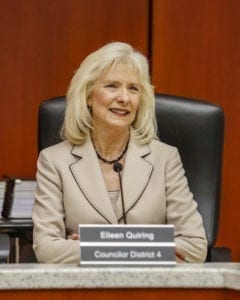 Clark County Councilor Eileen Quiring confirms members of the committee have had ‘very little clout’ in the process to submit proposal for Oregon’s plan to toll drivers on I-5 and I-205
Clark County Councilor Eileen Quiring confirms members of the committee have had ‘very little clout’ in the process to submit proposal for Oregon’s plan to toll drivers on I-5 and I-205
I must admit, I had very low expectations for the Portland Metro Area Value Pricing Advisory Committee. And, in spite of those low expectations, the committee and its process has managed to easily limbo quite comfortably under that bar I set so close to the ground.
The Value Pricing Committee was established last year by the Oregon Transportation Commission (OTC) to guide the Oregon Department of Transportation through the value pricing feasibility analysis. The committee will meet for the sixth and final time on Mon., June 25. The committee will then submit a proposal to the OTC as to how to move forward with Oregon’s proposal to place tolls on I-5 and I-205.
The committee consists of 25 members, three of whom are from Southwest Washington. Those three are Vancouver Mayor Anne McEnerny-Ogle, Clark County Councilor Eileen Quiring and Kris Strickler, a representative from the Washington State Department of Transportation (WSDOT).
Quiring recently provided some answers via email to questions I had about her experience on the committee. Unfortunately, those answers basically confirmed my perception that the committee has been a bit of a ruse, or farce, if you will.

“Regarding the Value Pricing Committee, I believe the opinions of the hired consultants seem to be more valued than those of the actual committee members,’’ Quiring wrote to me in a recent email. “There are many voices on the committee but it seems that we have so much ground to cover that the facilitator ‘keeps us moving along.’
“Like many government assembled committees that I have observed, unfortunately, it seems that ‘staff’ gets the lion’s share of the ‘juice’ – since they are considered the ‘professionals’ and we representatives (of groups or elected officials) or ‘citizen peons’ get a little time, but seemingly very little clout,’’ Quiring said. “Certainly considering the few in number from across the river (in Washington), I knew we would be very outnumbered, nevertheless I wanted to be a voice at the table.’’
Quiring pointed out that those who are seeking more information on the input from the public, the charter of the committee, and other details, can go to http://www.oregon.gov/ODOT/Get-Involved/Pages/Value-Pricing-Committee.aspx .
“The meeting on June 25, as I understand it, we are supposed to make a final recommendation to the Oregon Transportation Commission – who is supposed to make the final decision by the end of the year,’’ Quiring said.
“The County Council submitted a letter to the OTC near the beginning of the PAC meetings indicating our opposition to tolls on SW Washington commuters,’’ she said. “I will re-submit that letter at the meeting on June 25. I have also proposed mitigation for SW Washington commuters if they do impose tolls (which would be implemented in seven years), and that mitigation would be to reimburse some, at the very least, (if not all) of the tolls paid by the commuters from the Oregon income taxes that they currently pay because they work in Oregon. Apparently, the tolls can not be directly reimbursed, but since the income taxes have no such restriction, that is how this could be done. This suggestion was met with a yawn, like much of the public outcry regarding this tolling scheme.’’
 Quiring pointed out that she doesn’t even know how the original list of eight tolling options had been eliminated to three at the committee’s last meeting in May. Members of the committee have never been given the opportunity to vote on anything. In fact, committee members have been reminded multiple times that they are not a voting panel and consensus wasn’t needed in order to move forward.
Quiring pointed out that she doesn’t even know how the original list of eight tolling options had been eliminated to three at the committee’s last meeting in May. Members of the committee have never been given the opportunity to vote on anything. In fact, committee members have been reminded multiple times that they are not a voting panel and consensus wasn’t needed in order to move forward.
“They call this committee and the proposed tolls, ‘value pricing’ to reduce congestion,’’ Quiring said. “The problem is, they are proposing to use ‘general purpose lanes’ and turn them into HOV lanes and charge for those cars that use those lanes (possibly at certain times of the day – more of course during rush hour(s)). This rarely works. What it will likely cause is diversion to other surface streets. If they added more lanes, this could possibly work, but that isn’t the plan.
“For Washingtonians, if the tolls begin just south of each bridge, there is no way that they can divert unless they go by boat,’’ Quiring said. “Luckily plan ‘A’ has been eliminated from the mix (at our last meeting). This would have been the worst plan for SW Washington. However, plan ‘B’ would still be awful for us. If you ask me how plan ‘A’ got eliminated, I can’t tell you. I guess the consultants believed it wouldn’t be effective … we were asked as a committee if we agreed to eliminate it, and most of the members agreed.’’
So, while I called the committee’s work a “ruse’’ or a “farce,’’ Quiring has her own description.
“The bottom line is, I am participating, but even though I have put time and energy into this (as have those at ODOT that have held public meetings), I fear that it is a bit of a sham,’’ Quiring said. “I had high hopes at the beginning, but those hopes have all but dissolved.’’




 Clark County Councilor Eileen Quiring confirms members of the committee have had ‘very little clout’ in the process to submit proposal for Oregon’s plan to toll drivers on I-5 and I-205
Clark County Councilor Eileen Quiring confirms members of the committee have had ‘very little clout’ in the process to submit proposal for Oregon’s plan to toll drivers on I-5 and I-205